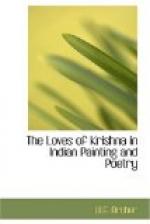She said to the joy of her heart,
Adorn the curl on my brow which puts the
lotus to shame, my spotless
brow,
Make a beautiful spot on my forehead,
a spot with the paste of the
sandal,
O giver of pride, on my tresses, untidy
now on account of desire, place
flowers,
Place on my hips the girdle, the clothes
and the jewels,
Cover my beautiful loins, luscious and
firm, the cavern of Love to be
feared.
Make a pattern upon my breasts and a picture
on my cheeks and fasten over
my loins a girdle,
Bind my masses of hair with a beautiful
garland and place many bracelets
upon my hands and jewelled
anklets upon my feet.
Krishna does so and with a final celebration of Krishna as God and of the song itself—its words ’sweeter than sugar, like love’s own glorious flavour’—the poem ends.
[Footnote 51: Note 18.]
[Footnote 52: Plate 20.]
[Footnote 53: Plates 21 and 22.]
[Footnote 54: Note 19.]
[Footnote 55: Plate 23.]
[Footnote 56: Plate 24.]
[Footnote 57: Plate 25.]
[Footnote 58: Plate 26.]
[Footnote 59: Plate 27.]
(iii) Later Poetry
Jayadeva’s poem quickly achieved renown in Northern and Western India and from the early thirteenth century became a leading model for all poets who were enthralled by Krishna as God and lover. In Western India, Bilvamangala, a poet of Malabar, composed a whole galaxy of Krishna songs, his poem, the Balagopala Stuti (The Childhood of Krishna) earning for him the title ‘the Jayadeva of the South.’ But it is during the fifteenth and sixteenth centuries that the most important developments occurred. In Bengal, the poets Vidyapati and Chandi Das flourished in about the year 1420, while in Western India, Mira Bai, a local princess, began a wide-spread popular movement. Mira Bai was followed by Vallabhacharya (born 1478) who in turn inspired four poet disciples—Krishna Das, Sur Das, Parmanand Das and Kumbhan Das. All these were at their height in the middle of the sixteenth century, writing Hindi poems in which Radha’s adventures with Krishna and their rapturous love-making were devotedly described.[60]
The work of Sur Das was of special importance for in one of his compositions he took each of the thirty-six traditional modes of Indian music-the Ragas and Raginis—but instead of celebrating them as separate ‘musical characters,’ appended to each a love-poem about Krishna. Sur Das was followed by Keshav Das of Orchha (fl. 1580), Govind Das (fl. 1590), Bihari Lai (fl. 1650) and Kali Das (fl. 1700)—all poets in whom religious ecstasy was blended with a feeling for passionate romance. Of these poets Bihari Lai is famous for the Sat Sai in which he celebrated Krishna’s romance in seven hundred verses.




